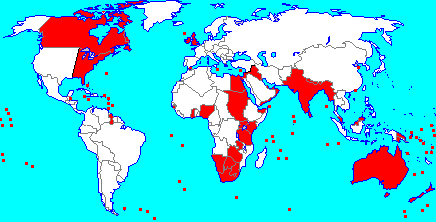America and the British Empire
Copyright © 2012, Henry J. Sage

British Government during the Colonial Era
It is important to remember that for the first hundred and seventy years of American history Americans were British—thus much of our early history was British history. It is also worth noting that much of our culture and our principles of governance were inherited from the British. Although not all of the colonists came from Great Britain, all were subject to the rule of the Crown. The colonists who had come from England, even if they left because they were unhappy with their lives, still for the most part cherished their English heritage. With the exception of Massachusetts and Connecticut, every colony was eventually named for something or someone English. Cities and towns were named after English counterparts, and many colleges and universities, such as William and Mary and King's College—which became Colombia University—were named as reminders of home.
The metaphor of parent and child has often been applied to the relationship in between the American colonies and England, but is good to remember that we can still respect our parents even when we are angry with them. The American Revolution did not occur overnight—the seeds were sown long before Lexington and Concord, and the point has been made elsewhere in these pages that, to a certain extent, the revolution began when the colonists left England in the first place. But until the last minute before the fighting started, and indeed even after, it is quite likely that the majority of American colonists still felt a sense of loyalty to the monarch. In 1774 George Washington wrote to a friend that independence from Great Britain was the last thing a colonial subject could wish for. As John Adams later claimed that during the revolution one third of the people were patriots, one third were loyalists, and the rest were uncommitted to either side. As we will see later, and parts of the country, colonists fought with the British against their American cousins.
It is useful to recall that until the beginning of the American Revolution (and even for a time after that), many Americans were loyal subjects of their royal majesties, the kings and queens listed below. One of the great paradoxes of Western history is that although these British monarchs were not always everything their subjects wished them to be, they ruled reasonably well, and their subjects were among the freest and best governed in the world. Monarchs such as Elizabeth I (the Great), known as “Good Queen Bess,” were beloved among their subjects. At the other extreme were Charles I and James II, both of whom were deposed. In general, however, kings and queens were believed to have the God-given right to rule, and most of themtook it seriously and tried to serve their subjects well. In any case, it is interesting that the first modern revolution of any size took place in the least likely country on Earth: Great Britain was seen as an enlightened monarchy even before the Age of Enlightenment.
| The British Royal House during the Colonial Period | ||
| Elizabeth I (the Great) | 1558-1603 | Daughter Of Henry VIII by Anne Boleyn |
| James I | 1603-1625 | James VI of Scotland, House of Stuart |
| Charles I | 1625-1649 | Executed 1649 during the English Civil War |
| The Protectorate | 1649-1660 | Oliver Cromwell Lord Protector; Richard Cromwell 1658 |
| Charles II | 1660-1685 | The Restoration |
| James II | 1685-1688 | Deposed in the “Glorious Revolution” of 1688 |
| William and Mary | 1689-1694 | Joint Rule. Battle of the Boyne in Ireland, 1690 |
| William III | 1694-1702 | William is of the House of Orange (Netherlands) |
| Anne | 1702-1714 | Last of the Stuarts. No surviving children. |
| George I | 1714-1727 | House of Hanover; Handel Court Composer |
| George II | 1727-1760 | Seven Years' War begins 1756 |
| George III | 1760-1820 | American Revolution 1775-1783 |
| The British Monarchy from 1066 to Present | ||
THE HOUSE OF TUDOR
England began to achieve political unity and assume its modern form under the Tudor monarchs who suppressed the powerful barons who threatened their rule. Henry VIII strengthened the Crown even further by leading the English Reformation, an immensely popular event for average men and women who hated the corrupt Catholic clergy. Henry’s reason for breaking with the Pope was to obtain a divorce, but he began a liberating movement that outlived him. During the reign of Queen Mary, who clung to the Roman Catholic faith, it seemed as if England would fall into a religious war, but the Protestant Reformation was too strong to be rolled back. The doctrine of predestination, the central tenet of the Reformation, might be seen as a belief leading to fatalism, but that was not the case. The doctrine inspired English men and women into heroic actions.
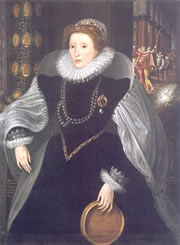 Elizabeth I. Elizabeth I, “the Great,” was monarch at the time of the founding of the Virginia colony, which is, of course, named for Elizabeth, the “Virgin Queen.” The life and reign of Elizabeth I are surrounded by romanticism and myth, but there can be little doubt that she was a strong monarch, as beloved by her people as any monarch in those times, an extremely competent, sophisticated and wily woman who used her femininity to good advantage and ruled with an iron fist when necessary. Surrounded by her favorites, some of whom may have been suitors or even lovers, she used her status as an unmarried sovereign to diplomatic advantage, playing friends and enemies against each other while keeping much of northwestern Europe hanging, wondering whom she might choose to favor. She chose never to marry.
Elizabeth I. Elizabeth I, “the Great,” was monarch at the time of the founding of the Virginia colony, which is, of course, named for Elizabeth, the “Virgin Queen.” The life and reign of Elizabeth I are surrounded by romanticism and myth, but there can be little doubt that she was a strong monarch, as beloved by her people as any monarch in those times, an extremely competent, sophisticated and wily woman who used her femininity to good advantage and ruled with an iron fist when necessary. Surrounded by her favorites, some of whom may have been suitors or even lovers, she used her status as an unmarried sovereign to diplomatic advantage, playing friends and enemies against each other while keeping much of northwestern Europe hanging, wondering whom she might choose to favor. She chose never to marry.
Elizabeth's half-sister Mary, known as “Bloody Mary” because of the executions committed during her reign, was also a tough monarch. She retained her Roman Catholic faith upon succession, thus reversing the step taken by her father, who had replaced the Catholic Church with the Church of England. Among those executed by order of Queen Mary was the 16-year-old Lady Jane Grey, a Protestant, who had what some believed was a legitimate right to the crown. (She was known as the “Nine-day Queen.”) If Queen Elizabeth had carried out her hard decisions, such as the execution of her cousin, Mary Queen of Scots, in as brief a period as did Mary, she might well have been known as Bloody Bess instead of Good Queen Bess. Whatever Elizabeth was or was not, the Elizabethan Era, known for the literature of Shakespeare and his contemporaries, the King James version of the Bible, along with the colonization of North America, the defeat of the Spanish Armada, and the growth of England towards becoming the most powerful nation in the world are all parts of her legacy.
THE HOUSE OF STUART
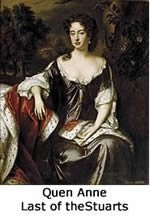 As Queen Elizabeth never married and thus had no heirs, the British monarchy passed to the House of Stuart in the form of James I, who had been James VI of Scotland. Noted especially for forming a commission to create a new translation of the Bible, the King James version, James was reasonably tolerant of religious dissenters within the realm. His son Charles I, however, became embroiled in a quarrel with Parliament that had strong religious overtones because of his perceived discrimination against the Puritans. The conflict led to the English Civil War, which ultimately resulted in Charles’s execution for treason in 1649.
As Queen Elizabeth never married and thus had no heirs, the British monarchy passed to the House of Stuart in the form of James I, who had been James VI of Scotland. Noted especially for forming a commission to create a new translation of the Bible, the King James version, James was reasonably tolerant of religious dissenters within the realm. His son Charles I, however, became embroiled in a quarrel with Parliament that had strong religious overtones because of his perceived discrimination against the Puritans. The conflict led to the English Civil War, which ultimately resulted in Charles’s execution for treason in 1649.
Upon Charles’s death a monarchy was abolished and the Republic called the Commonwealth of England was established under the leadership of Oliver Cromwell, the Lord Protector. Upon Oliver’s death, his authoritarian regime was continued under his son Richard, but the Republic was abandoned in 1660 with the restoration of King Charles II. Charles was succeeded by his brother, James II, a Roman Catholic, whose religion led to his overthrow in the Glorious Revolution of 1688.
The crown then devolved upon James’s daughter Mary and her husband, William of Orange. They ruled jointly as William and Mary until Mary’s death in 1694, after which William continued to rule as William III. Religious strife continued under William, and fearing a Catholic uprising that might attempt to restore James to the throne, he led English troops in Ireland in the Battle of the Boyne, defeating the Catholics. Protestants who supported William stayed on mostly in Northern Ireland, and they became known as Orangemen. The enmity between them and the Catholics in the southern part of Ireland persisted until modern times, and they erupted into what became known as “The Troubles,” a partisan war that lasted for about 30 years. William was succeeded by Mary’s sister Anne, whose reign lasted from 1702 to 1714. Although she had many children, none of them survived to adulthood, and upon her death the monarchy passed to the German House of Hanover.
THE HOUSE OF HANOVER
As Queen Anne’s health deteriorated, and because none of her children had survived to adulthood, the question of who would succeed her became a political issue. Two acts during Queen Anne’s reign were relevant. First, the Act of Union in 1707 united England and Scotland into a single Kingdom of Great Britain. Second, the act of settlement of 1701 determined that the succession to the ground would go to the 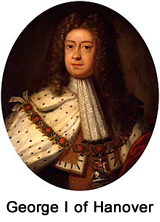 House of Hanover rather than to the Stuarts, who remained Catholic. Sophia Electress of the Holy Roman Empire was the heir apparent, but she died before Anne. Thus when Anne died the throne passed to Sophia's son, George I, and the House of Hanover continued to rule through the reign of Queen Victoria. Because George was an unpopular king (he spoke German, not English), there was considerable political turmoil during his reign, and political power began to shift more and more from the monarch to Parliament, and the office of prime minister emerged as a a powerful political force strong enough to challenge the king's authority at times.
House of Hanover rather than to the Stuarts, who remained Catholic. Sophia Electress of the Holy Roman Empire was the heir apparent, but she died before Anne. Thus when Anne died the throne passed to Sophia's son, George I, and the House of Hanover continued to rule through the reign of Queen Victoria. Because George was an unpopular king (he spoke German, not English), there was considerable political turmoil during his reign, and political power began to shift more and more from the monarch to Parliament, and the office of prime minister emerged as a a powerful political force strong enough to challenge the king's authority at times.
George I was succeeded by his son George II, the last British monarch born outside Great Britain. He was an ineffective monarch and unpopular like his father, and during his reign there were attempts to replace him on the throne. Political power continued to shift more and more to Parliament and the prime minister. George’s relationship with his son was also difficult, and as his son died while his father was still alive, George was succeeded by his grandson, George III.
Like his predecessor, George III struggled with political issues. Two political parties had emerged in Great Britain, the Tories, who supported a strong monarch, and the Whigs, who favored a strong parliamentary opposition. George was supported by the Tories, but the Whigs in Parliament offered substantial opposition, and he was widely criticized by tthe Whigs in Parliament. He was not an effective monarch, and the turmoil between his Tory ministers and the Whigs in Parliament who opposed his policies contributed to the mishandling of the rebellion in America that led to the war for independence. He also suffered periods of mental instability, which contributed to the ineffectiveness of his reign. During the last decade of his life from 1810 to 1820, George was completely insane, and England was ruled by his son, the Prince of Wales, who became George II. As it turned out, however, George II was at least as ineffective a monarch as his father, but fortunately Great Britain was not engaged in any foreign conflicts during his reign except for the Crimean War, during which the British were supported by the French and the Ottoman Empire.. The reign of George III will be discussed further in the section on the American Revolution.
“The Sun never sets on the British Empire.”
History shows that the popular saying above was true, as British dominions stretched around the globe in both the northern and southern hemispheres. Following World War II the Empire began to shrink, as former British territories like India gained their independence. But even today, Canada, Australia and other areas are part of the British Commonwealth of Nations, and the English flag still flies over such areas as Gibraltar, Bermuda, and other smaller entities. During the colonial era prior to 1763 Great Britain felt threatened by the growing dominance of the Netherlands, Spain, Portugal and France as they develop their own empires, thus increasing their share of the world's riches. British colonization of North America was an attempt to make inroads into the dominance of those other European nations. By the mid-1700s, the North American colonies had demonstrated that their investment in colonialism was paying off. The British government by 1750 did not anticipate coming American Revolution, but in some ways the seeds of rebellion had already been sowed—more on that below. |
Ireland: English Colonization & English Brutality
Shortly after the English Reformation, Henry VIII decided to bring Ireland under crown control. Over the next century all of Ireland became subject to British rule. The English monarchs Elizabeth I and James I did this by creating plantations, sending English and Scottish colonists to occupy territory which was confiscated from its Irish owners. They gradually spread their control over virtually all of the island. They failed, however, to quell the Catholic religion still practiced by the Irish people, and they employed brutal methods to establish and maintain firm control, establishing a pattern for future colonization. People who openly practiced the Catholic faith faced execution, and priests often held Mass in wooded areas, barns or other places where they could not be observed.
English rulers from Elizabeth I through the Stuart monarchs used Ireland as a testing ground for their theories of colonial rule. Military governors of the Irish colonies often used martial law to bring the natives under English rule. The English went into Ireland convinced that theirs was a superior way of life. The Irish seemed backward but reluctant to change their ways. The fear of a Catholic uprising was always present, as pretenders to the throne sometimes viewed Ireland as a stepping stone to get at English rulers. Needless to say, when the English seized Irish land by force, the Irish resisted. The English resorted to massacres of women and children. In Ireland, men like Sir Humphrey Gilbert, Sir Walter Raleigh, and Sir Richard Grenville learned the techniques of colonization that they would later apply in America.
English rule over Ireland continued to be harsh over succeeding centuries, eventually leading to the period known as The Troubles during the late 20th century. Today Northern Ireland, which was separated from the Republic of Ireland by the British, is relatively peaceful, but resentment of past injustices remains.
The Glorious Revolution of 1688
When James II ascended to the throne, the English were afraid that he intended to return the nation to Catholicism. Parliament rebelled, and in the Glorious (bloodless) Revolution deposed James and offered the crown to his daughter Mary and her Dutch Protestant husband, William of Orange. They ruled jointly as William and Mary until Mary’s death, after which William ruled alone as William III. In America, James II had created the “Dominion of New England” in an attempt to control all colonies down to New Jersey. The tough, unyielding Governor Andros was felt to be oppressive and was overthrown.
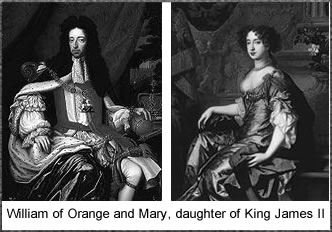 The Glorious Revolution had long-term effects on America: The philosophy that emerged from the event, elucidated in John Locke’s Second Treatise on Government, became a cornerstone of American political thinking. The revolution (and Locke’s explanation and justification of it) undermined claims for authoritarian government and argued essentially that men (and women) had the inherent right to participate in their own governance. According to Locke, people had certain rights—to life, liberty, and property—and the government was responsible for protecting those rights for all citizens. Locke’s thinking was invoked by Jefferson and the other founding fathers as justification for revolution and also as a basis for our Bill of Rights. Locally, the Revolution of 1688 helped propel the citizens of Massachusetts to overthrow Governor Andros.
The Glorious Revolution had long-term effects on America: The philosophy that emerged from the event, elucidated in John Locke’s Second Treatise on Government, became a cornerstone of American political thinking. The revolution (and Locke’s explanation and justification of it) undermined claims for authoritarian government and argued essentially that men (and women) had the inherent right to participate in their own governance. According to Locke, people had certain rights—to life, liberty, and property—and the government was responsible for protecting those rights for all citizens. Locke’s thinking was invoked by Jefferson and the other founding fathers as justification for revolution and also as a basis for our Bill of Rights. Locally, the Revolution of 1688 helped propel the citizens of Massachusetts to overthrow Governor Andros.
Many new immigrants arrived in America during the period 1700–1750, increasing the population almost tenfold, a huge increase in terms of percentage. Many were non-English, including Germans and Scots from Northern Ireland, called Ulstermen (and later Scots-Irish). They settled heavily in Pennsylvania and migrated down through the Shenandoah Valley into Virginia and even farther south. The Ulster Irish had felt religious and economic oppression at the hands of their English masters and tended to be rebellious. When the time came for the Revolution, they fought the British in large numbers. From the ranks of the Ulster settlers came America’s first Irish-American president, Andrew Jackson. The Germans came in large number, and in parts of Pennsylvania outnumbered the English. They were good citizens—hard working and peaceful, they blended nicely into the Quaker colony. They did often find themselves culturally at odds with their English neighbors, but the Germans, like the Ulster Irish, were more interested in finding prosperity than in quarreling with the English or worrying about religious issues.
Thus, changes in British policy often had a significant effect on the colonies, from changes in migration patterns to quarrels over religious differences and shifting patterns in the colonies themselves. In any case, until 1776 whatever to monarch and Parliament decided about how the colonies were to be treated, the colonists were treated as loyal subjects, but subjects who had no say in how they were governed. Resentment over their subservient condition was not deep for the first 150 years of British rule, but that began to change dramatically after 1763, as we shall see.
| Sage History Home | Colonial America | British Government of the Colonies | The American Revolution |
| Updated June 1, 2020 | |||
